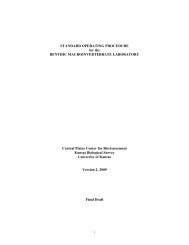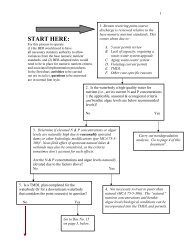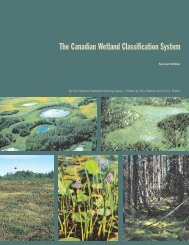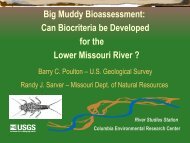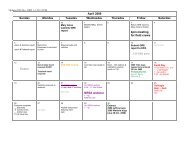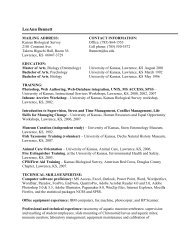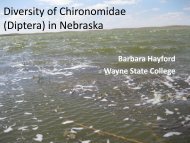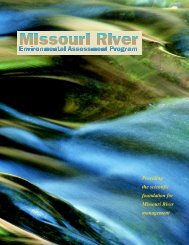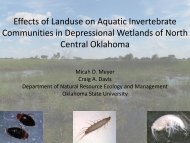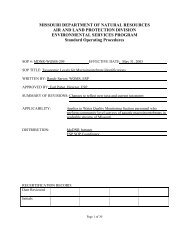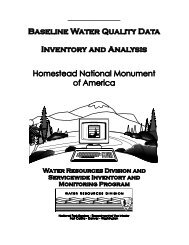Koontz, J., D.G. Huggins, C.C. Freeman, D.S. Baker - Central Plains ...
Koontz, J., D.G. Huggins, C.C. Freeman, D.S. Baker - Central Plains ...
Koontz, J., D.G. Huggins, C.C. Freeman, D.S. Baker - Central Plains ...
Create successful ePaper yourself
Turn your PDF publications into a flip-book with our unique Google optimized e-Paper software.
from analysis did not show significant difference (p = 0.23) in variance or mean plant richness<br />
between 2005 and 2009, however the differences in means and variance were found to be even<br />
more significant (p = 0.000) with the exclusion of 2009 samples during the comparison between<br />
2005 and 2008. This indicates that 2009 plant richness values span the ranges of both the 2005<br />
and 2008 samples and sites have similar plant richness qualities of both.<br />
Plant Richness - Native Species<br />
Significant differences (p = 0.001) in variance and mean native plant richness values were found<br />
between 2005 (mean = 36.10, STDERR = 2.73) and 2008 (mean = 21.81, STDERR = 2.21)<br />
when all years were included in the ANOVA and Tukey-Kramer multiple comparison test<br />
(Figure 20). The mean native plant species for 2009 was 30 (STDERR = 3.96) and was not<br />
significantly different (p = 0.20) from 2005 (Figure 20). Exclusion of 2009 showed that 2005<br />
and 2008 variance and mean native plant richness values remained significantly different (p <<br />
0.000). Because the number of lacustrine, palustrine and riverine wetlands sampled in each of<br />
the study years was so uneven, no meaningful ANOVA testing for yearly differences among<br />
these groups could be accomplished. The number of wetland types sampled in any one year<br />
varied from one to 22. No significant differences in native plant richness were found among<br />
wetlands when grouped by ecoregion (Western Corn Belt <strong>Plains</strong> n = 38, <strong>Central</strong> Irregular <strong>Plains</strong><br />
n = 20, Interior River Valleys and Hills n = 5). Emergent macrophytes bed type (EM) differed<br />
significantly from both the mix (MIX) and unconsolidated bed (UB) types (see Beury 2010 for<br />
wetland type definitions). Further inspection of these types revealed that of the 33 EM sites, 25<br />
sites were palustrine, 5 sites were lacustrine, and 3 sites were riverine. Native plant richness<br />
among lacustrine EM (30.6) was not significantly different from palustrine EM (36.72). It<br />
should be noted that all the lacustrine EM sites were littoral zone sites associated with large<br />
lakes. The MIX category consisted of two palustrine sites and four lacustrine sites (two limnetic<br />
and two littoral). All the MIX wetland types were observed as having native species richness<br />
from 15-16 species.<br />
ANOVA and Tukey-Kramer tests revealed that the lacustrine UB types (n = 6, mean 12,<br />
STDERR 4.46) were significantly lower (p = 0.011) in native plant richness than the palustrine<br />
sites (n = 5, mean = 32.8, STDERR = 4.89). Within the lacustrine class, the littoral zone sites (n<br />
= 4) had higher mean native plant richness (13.25) than the limnetic zone (9.5), though these<br />
differences were not statistically significant. Other MIX types had higher native plant diversity;<br />
the riverine sites had a native plant richness value of 16 while the palustrine sites had 32.8.<br />
These distinct separations among the MIX category dramatically affect its perceived relationship<br />
among this and other parameters. When we look at the differences between types among<br />
palustrine and lacustrine sites we see no significant differences (p = 0.08). All palustrine sites<br />
appear to be similar in plant community structure. Within lacustrine sites, AB had significantly<br />
higher FQI native values (p = 0.004) and FQI total score (p = 0.002) than MIX and UB classes.<br />
Distinct differences exist between aquatic bed (AB) and both the MIX and the unconsolidated<br />
bed types of lacustrine sites. The UB wetlands and MIX categories of lacustrine sites are very<br />
similar to one another in vegetation attributes. AB sites appear to be higher quality wetlands.<br />
The littoral zone emergent macrophyte beds that were sampled from lakes were not significantly<br />
different from the aquatic bed, MIX, or unconsolidated bed classes. If the MIX class is a<br />
combination of all three types it appears that in the case of lacustrine sites it is most affected by<br />
the unconsolidated bed and that among the palustrine sites it is an arbitrary or non-distinct class,<br />
at least in terms of vegetative quality.<br />
33 of 84



